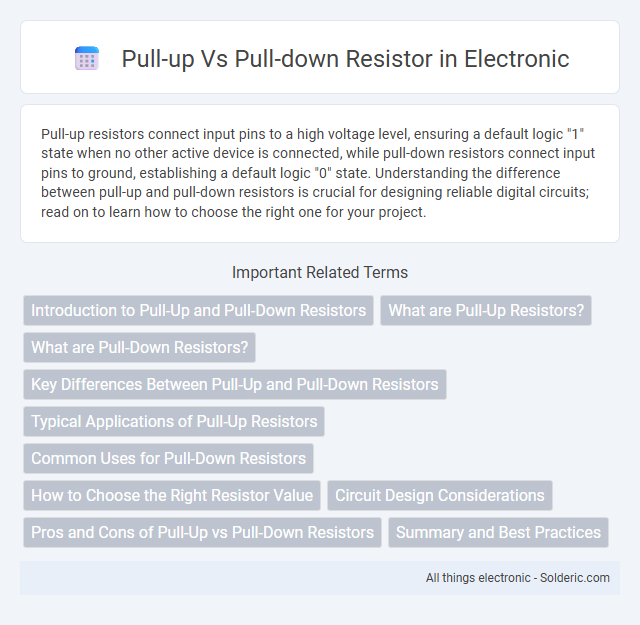Pull-up resistors connect input pins to a high voltage level, ensuring a default logic "1" state when no other active device is connected, while pull-down resistors connect input pins to ground, establishing a default logic "0" state. Understanding the difference between pull-up and pull-down resistors is crucial for designing reliable digital circuits; read on to learn how to choose the right one for your project.
Comparison Table
| Feature | Pull-up Resistor | Pull-down Resistor |
|---|---|---|
| Function | Connects input to high voltage (Vcc) to ensure default HIGH state | Connects input to ground (GND) to ensure default LOW state |
| Default Logic Level | HIGH (1) | LOW (0) |
| Common Use | Ensures input reads HIGH when switch is open | Ensures input reads LOW when switch is open |
| Connection | Between input pin and Vcc | Between input pin and GND |
| Typical Resistance | 1 kO to 100 kO | 1 kO to 100 kO |
| Power Consumption | Consumes current when input is LOW | Consumes current when input is HIGH |
| Example Application | Microcontroller input pins, I2C lines (SDA, SCL) | Button inputs, chip enable pins |
Introduction to Pull-Up and Pull-Down Resistors
Pull-up and pull-down resistors are essential components in digital circuits used to ensure a defined logic level on input pins when no active device is connected. A pull-up resistor connects the input to a high voltage level (usually Vcc), while a pull-down resistor connects the input to ground, preventing floating inputs that can cause unpredictable behavior. Your circuit's reliability improves significantly by stabilizing signals with the correct resistor type based on the desired default logic state.
What are Pull-Up Resistors?
Pull-up resistors connect a signal line to a positive voltage supply, ensuring a defined logic high level when no active device drives the line. They prevent floating inputs that can cause unpredictable behavior in digital circuits. Your microcontroller's input pins rely on pull-up resistors to maintain stability and avoid false triggering.
What are Pull-Down Resistors?
Pull-down resistors are components connected between a circuit pin and ground to ensure the pin reads a definite low voltage (0V) when no active signal is present. They prevent floating inputs by providing a default logic LOW level, which enhances circuit stability and reduces noise interference. Your circuit relies on pull-down resistors to maintain consistent signal integrity and prevent erratic behavior in digital electronics.
Key Differences Between Pull-Up and Pull-Down Resistors
Pull-up resistors connect an input pin to a high voltage level (typically Vcc) to ensure a default logical HIGH state, while pull-down resistors connect the pin to ground, ensuring a default logical LOW state. The choice between pull-up and pull-down resistors depends on the circuit's logic requirements and the input device's behavior, influencing noise immunity and power consumption. Your design will benefit from selecting the appropriate resistor type to maintain stable and predictable digital input signals.
Typical Applications of Pull-Up Resistors
Pull-up resistors are commonly used in digital circuits to ensure a defined logic level when switches or inputs are open or not actively driven, preventing floating inputs that can cause erratic behavior. They are essential in microcontroller input pins to maintain a stable high logic state, especially in applications like button presses, I2C bus lines, and open-drain or open-collector outputs. Pull-up resistors also facilitate reliable communication in interfacing sensors and modules, ensuring signal integrity and reducing power consumption.
Common Uses for Pull-Down Resistors
Pull-down resistors are commonly used to ensure a known low logic level on input pins when no active signal is present, preventing floating inputs that can cause erratic behavior. They are essential in digital circuits for initializing switches, buttons, and microcontroller inputs to a defined ground state. Your designs benefit from pull-down resistors by maintaining signal integrity and avoiding unintended activation in the absence of input signals.
How to Choose the Right Resistor Value
Choosing the right pull-up or pull-down resistor value depends on balancing power consumption and signal integrity. Typically, resistor values range from 1 kO to 100 kO; lower values reduce noise and improve switching speed but increase current draw, while higher values save power but risk signal instability. Factors such as the input pin's leakage current, bus capacitance, and operating voltage level are critical in determining the optimal resistor value for reliable digital input readings.
Circuit Design Considerations
Pull-up and pull-down resistors serve to establish defined voltage levels on input pins, preventing floating states that cause unpredictable circuit behavior. Design considerations include choosing resistor values typically between 1kO and 100kO to balance current consumption and noise immunity while ensuring a stable logic level. The choice between pull-up or pull-down depends on the specific chipset or logic family requirements, signal polarity, and power consumption constraints.
Pros and Cons of Pull-Up vs Pull-Down Resistors
Pull-up resistors ensure a default high state, preventing floating inputs and reducing noise susceptibility, but they can increase power consumption when the input is driven low. Pull-down resistors, by providing a default low state, are effective for active-high inputs and help avoid false triggering, though they may not be suitable for all circuits due to potential issues with logic compatibility. Choosing between pull-up and pull-down resistors depends on your circuit's logic level requirements, noise tolerance, and power efficiency goals.
Summary and Best Practices
Pull-up resistors connect a signal line to a positive voltage to ensure a defined high state, while pull-down resistors connect to ground to guarantee a low state, preventing floating inputs that can cause unpredictable behavior in digital circuits. Best practices include selecting resistor values between 4.7kO and 10kO to balance power consumption and signal integrity, and choosing pull-up resistors for inputs interfacing with open-drain or open-collector outputs, while pull-down resistors are preferred for circuits needing a default low state. Proper implementation of pull-up or pull-down resistors enhances circuit stability, reduces noise susceptibility, and ensures reliable logic level detection.
pull-up vs pull-down resistor Infographic

 solderic.com
solderic.com